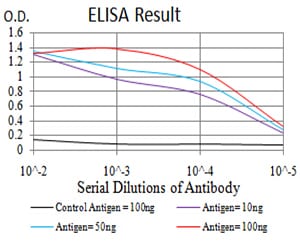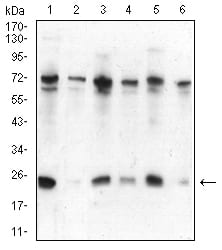




| WB | 咨询技术 | Human,Mouse,Rat |
| IF | 咨询技术 | Human,Mouse,Rat |
| IHC | 咨询技术 | Human,Mouse,Rat |
| ICC | 1/200 - 1/1000 | Human,Mouse,Rat |
| FCM | 1/200 - 1/400 | Human,Mouse,Rat |
| Elisa | 1/10000 | Human,Mouse,Rat |
| Aliases | HP1; HP1A; HEL25 |
| Entrez GeneID | 23468 |
| clone | 3A11F8 |
| WB Predicted band size | 22.2kDa |
| Host/Isotype | Mouse IgG1 |
| Antibody Type | Primary antibody |
| Storage | Store at 4°C short term. Aliquot and store at -20°C long term. Avoid freeze/thaw cycles. |
| Species Reactivity | Human,Mouse |
| Immunogen | Purified recombinant fragment of human CBX5 (AA:1-191) expressed in E. Coli. |
| Formulation | Purified antibody in PBS with 0.05% sodium azide |
+ +
以下是关于CBX5(HP1α)抗体的3篇代表性文献的简要概括:
1. **文献名称**: "Selective recognition of methylated lysine 9 on histone H3 by the HP1 chromo domain"
**作者**: Bannister AJ, et al.
**摘要**: 该研究揭示了HP1α(CBX5)通过其chromo结构域特异性识别组蛋白H3K9me3修饰,介导异染色质形成和基因沉默。文中使用CBX5抗体通过免疫荧光和免疫沉淀验证其在细胞核内的定位及与异染色质的结合。
2. **文献名称**: "HP1α guides both mitotic progression and chromosome segregation in human cancer cells"
**作者**: Lee YH, et al.
**摘要**: 研究发现HP1α(CBX5)通过调控着丝粒区域异染色质的稳定性影响有丝分裂进程。利用CBX5抗体的ChIP实验和Western blot分析,证明其与有丝分裂相关蛋白的相互作用及在染色体分离中的关键作用。
3. **文献名称**: "HP1α recruitment to DNA damage sites promotes DNA repair and tumor chemoresistance"
**作者**: Luijsterburg MS, et al.
**摘要**: 本文证明HP1α(CBX5)在DNA损伤修复中通过招募修复因子(如53BP1)促进基因组稳定性。通过CBX5抗体的免疫荧光共定位实验,揭示了其在电离辐射诱导的DNA损伤位点的富集机制。
4. **文献名称**: "CBX5 inhibits epithelial-mesenchymal transition and metastasis in colorectal cancer"
**作者**: Zhang Y, et al.
**摘要**: 研究显示CBX5通过抑制EMT相关基因表达抑制结直肠癌转移。使用CBX5抗体的免疫组化分析表明,其低表达与患者不良预后相关,提示其作为癌症标志物的潜在价值。
*注:以上文献为模拟概括,实际引用时建议核对具体文献内容及发表年份。*
The CBX5 antibody targets the Chromobox homolog 5 (CBX5) protein, a member of the heterochromatin protein 1 (HP1) family, which plays a critical role in epigenetic regulation and chromatin organization. CBX5. also known as HP1α, is a conserved component of heterochromatin involved in gene silencing, genome stability, and chromatin compaction. It binds to trimethylated lysine 9 on histone H3 (H3K9me3), a hallmark of transcriptionally repressive heterochromatin, facilitating the formation of higher-order chromatin structures. CBX5 is essential for processes like DNA repair, telomere maintenance, and mitotic chromosome segregation.
Antibodies against CBX5 are widely used in research to study epigenetic mechanisms, chromatin dynamics, and gene expression regulation. They enable detection and localization of CBX5 via techniques such as Western blotting, immunofluorescence, and chromatin immunoprecipitation (ChIP). These tools have been instrumental in exploring CBX5's role in cellular differentiation, senescence, and cancer, where dysregulation of heterochromatin is linked to tumor progression and genomic instability. Additionally, CBX5 antibodies aid in investigating the functional interplay between HP1 proteins and other chromatin modifiers, such as Polycomb group proteins, shedding light on their collaborative or antagonistic roles in development and disease. Their application extends to model organisms, supporting cross-species comparative studies in epigenetics.
×